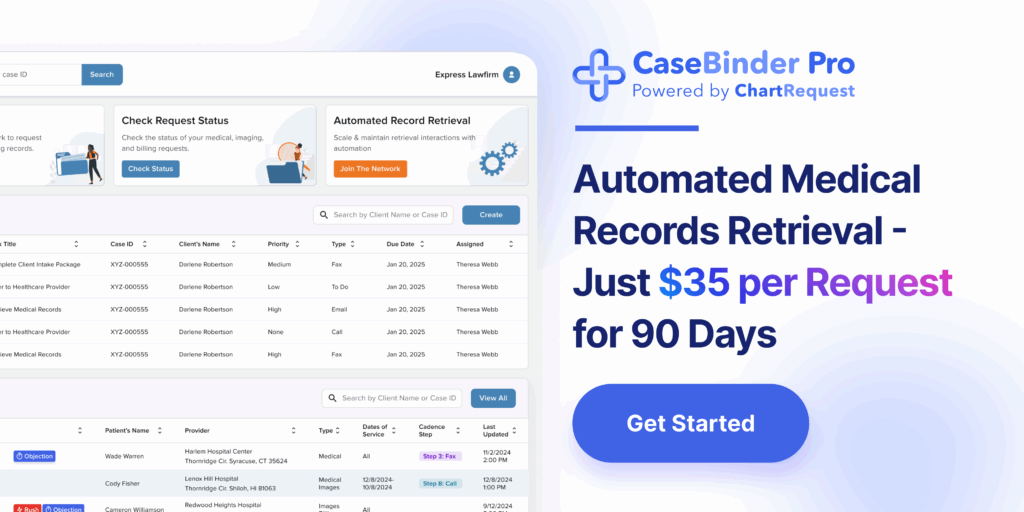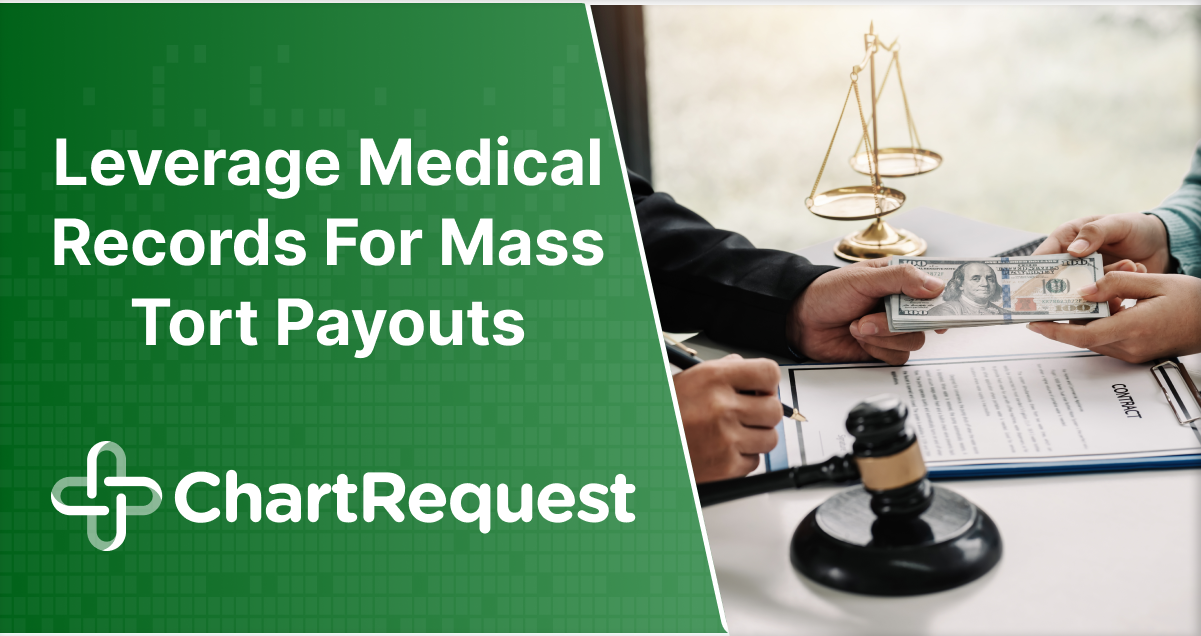Your law firm works hard to maximize the mass tort payouts of personal injury clients. However, your success depends on the quality and quantity of medical evidence supporting your case.
In this article, our record retrieval specialists explain how CaseBinder software and support can help you collect the medical documentation you need to confidently present your clients’ mass tort claims.
Consider the following information, then book a free consultation with ChartRequest to discuss how our Full-Service retrieval solution can streamline your discovery process.
Expected Payouts for Mass Tort Lawsuits
Unlike individual personal injury claims — with payouts that average between $10,000 and $50,000 — you should expect mass tort lawsuits to yield higher settlements.
Some estimates value mass tort payouts between $100,000 to $1 million depending on the injuries sustained and number of victims.
Pursuing the highest judgment for your clients is contingent on numerous variables, including:
- Understanding Your Client: Some clients want to resolve mass tort cases quickly and collect the payouts, which may encourage your legal team to hasten the discovery process. This urgency may prevent you from leveraging quality evidence for high payouts unless you partner with a speedy and compliant record retrieval company like ChartRequest.
- Designating Roles: Your legal team may be small, and paralegals may not have time to contact healthcare providers for client injury diagnoses and treatment expense information. Investing in a full-service platform to streamline outreach and retrieval is the best way to allocate resources to other aspects of building your mass tort case.
- Analyzing Documentation: A complete and accurate record of your clients’ medical conditions is valuable to your case. CaseBinder will ensure that your legal team can review the full picture of your clients’ health before the negotiation phase of your lawsuit.
Choosing CaseBinder for Compliant and Timely Record Retrievals
As you can see in the previous section, choosing a reliable full-service platform for record requests can save your law firm time and money while fighting for mass tort payouts. Consequently, you may achieve higher settlements for your clients and improve the reputation of your business.

CaseBinder is a wise choice for personal injury, medical malpractice, and occupational injury attorneys. The tool offers an intuitive user interface for high-volume requests and access to a large and growing network of over 70,000+ healthcare providers in the United States.
A single document request can take hours to complete and submit without a specialist’s help. With ChartRequest, we can help you navigate the release of information process quickly, ensuring that you get all the documents you need without delay.
Understanding how to use CaseBinder will ensure that you and your paralegals are confident in the planning necessary to optimize mass tort payouts.
Authorizing Requests for Client Medical Records
Authorizing requests through CaseBinder and the ChartRequest tool is easy!
Simply submit your credentials as a legal representative to your client and wait for verification information. The tool may ask you to provide your name, date of birth, or other documents to confirm your identity.
Take Care To Avoid HIPAA Violations
Many attorneys worry about inadvertent HIPAA violations during the discovery process. These violations could cost your law firm thousands of dollars if you make mistakes or illegal disclosures during your investigation. It also may prevent you from using certain pieces of evidence, which could reduce your ability to achieve a high mass tort payout for your clients.
HIPAA rules and regulations can be confusing to navigate without the proper guidance. Here are some of the laws and regulations to monitor during your record requests:
- Minimum Necessary Standard (MNS): Patients have a right to receive confidential care after experiencing an injury. The MNS protects their health information from accidental disclosures. Hence, you can only request and access relevant documents to your clients’ mass tort cases.
- The Security Rule: HIPAA regulates the transfer of sensitive medical information, recommending that custodians of protected health data provide adequate cybersecurity measures and monitoring during use. Fortunately, CaseBinder provides an encrypted data transfer workflow monitored by human record exchange specialists.
- 30-Day Rule: As a legal requestor, you can access documents within 30 days of submitting a valid, signed authorization for your request.
Preparing and Presenting Evidence to Court
Now that you recognize the general considerations of HIPAA and requesting a document with CaseBinder, it’s time to decide which records you need. Medical records related to your clients’ injuries and treatments help maximize payouts during mass tort cases.
Here are some items to include in your evidence portfolio:
- The name and contact information of the victim
- The nature and severity of the victim’s injuries
- The approximate time and date of the injury
- The recommended treatment plan prescribed by a physician
- The expected costs of the prescribed treatment plan
- The time expected to complete treatment
- Relevant doctor’s notes
- Progress of the treatment
- Other relevant billing information
A comprehensive outline of the clients’ financial losses and physician injuries will pressure the opposition into offering a higher settlement. If the case moves to trial, these items will allow the jury to understand the severity of the claim.
Negotiating a Higher Mass Tort Payout for Clients
Like most personal injury lawsuits, clients usually expect the liable party to cover their medical expenses. When planning your negotiations, it’s best to start there before working toward a higher payout. Scrutinize the digital records from the CaseBinder platform and calculate the damages.
Having a paralegal or assistant attorney review the math is wise to ensure your team addresses each expense.
Once you have a baseline number to work with, it’s up to your team to devise a strategy that will meet your clients’ unique expectations. Don’t forget to keep their medical records nearby for a quick reference! CaseBinder allows you to access these documents through a desktop or a mobile device.
Enhance Your Mass Tort Case Outcomes With ChartRequest
Don’t waste valuable time on the phone contacting dozens of healthcare providers for your mass tort case. At ChartRequest, we offer a full-service plan that will do all the leg work for your law firm!
Our team will handle all the communications, verifications, and record exchange on your behalf. This way, you can avoid HIPAA anxiety and other roadblocks that prevent you from negotiating a higher mass tort payout!
Schedule a no-cost consultation today to learn more about how CaseBinder Full-Service can streamline your future cases.
Follow us on social media for more product updates and content.


